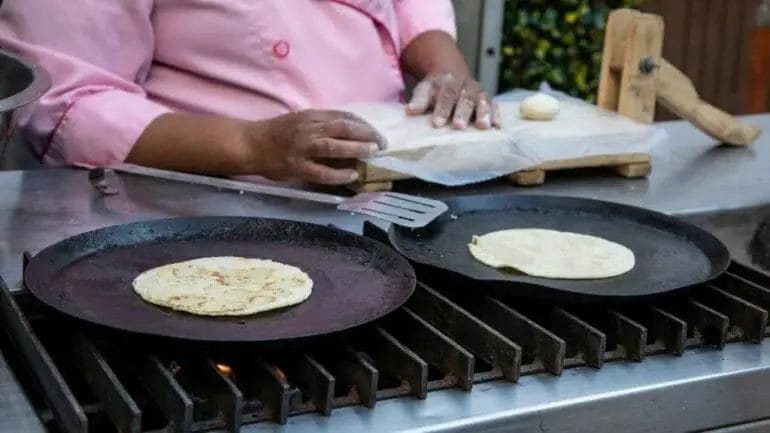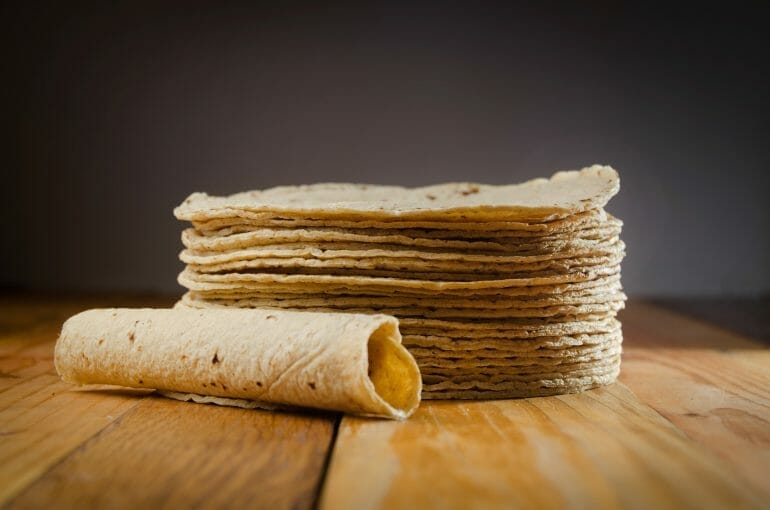A tortilla pan is called a comal. It is a traditional Mexican cooking utensil that is specifically designed for making tortillas.
The comal is typically made of cast iron or other types of metal and has a flat, round surface. It is used to heat and cook the dough, resulting in perfectly cooked and delicious tortillas.
The comal is an essential tool in Mexican cuisine and is also used to cook other flatbreads and foods. Read on to learn more about comal.

The Science Behind Cooking Tortillas: Exploring the Role of Tortilla Pans
Tortillas are a staple food in many cultures, particularly in Mexican cuisine. These versatile flatbreads can be used in a variety of dishes, from tacos and quesadillas to enchiladas and wraps. While tortillas can be cooked on a regular stovetop or griddle, using a tortilla pan can make a significant difference in the texture, flavor, and overall cooking experience.
So, what exactly is the science behind cooking tortillas? And how does the choice of pan affect the final product? Let’s dive deeper into the role of tortilla pans in achieving perfectly cooked tortillas.
The Role of Tortilla Pans
Tortilla pans, also known as comals or griddles, are specifically designed for cooking tortillas. They are typically made of cast iron or other heat-retaining materials, which helps distribute and retain heat evenly during the cooking process.
When tortilla dough is placed on a tortilla pan, the heat causes the water content in the dough to evaporate, creating steam. This steam helps to puff up the tortilla, giving it a light and airy texture. The even heat distribution ensures that the tortilla cooks evenly on both sides, preventing any undercooked or burnt spots.
The Importance of Heat Retention
One of the key advantages of using a tortilla pan is its ability to retain heat. Cast iron pans, in particular, excel in this aspect. When a tortilla pan is preheated properly, it can hold and distribute heat consistently, allowing the tortillas to cook evenly.
The heat-retaining properties of tortilla pans are especially important when it comes to achieving a perfectly browned exterior. The hot surface of the pan creates a Maillard reaction, which is a chemical reaction between amino acids and reducing sugars. This reaction results in the desirable golden-brown color and delicious flavor in the tortillas.
Enhancing Flavor and Texture
Using a tortilla pan not only ensures even cooking but also enhances the flavor and texture of the tortillas. The combination of heat retention and even heat distribution results in a slightly crispy exterior and a tender, chewy interior.
The dry heat provided by the tortilla pan also helps to develop flavor by caramelizing the natural sugars in the dough. This caramelization adds depth and complexity to the taste of the tortillas, making them more enjoyable to eat.
Choosing the Right Tortilla Pan
When it comes to choosing a tortilla pan, there are a few factors to consider. Firstly, consider the material. Cast iron is a popular choice due to its excellent heat retention and durability. However, other materials like carbon steel and non-stick pans can also be used.
Additionally, consider the size of the pan. The ideal size depends on your preference and the quantity of tortillas you plan to cook at once. A smaller pan may be suitable for personal use, while a larger pan can accommodate more tortillas.
Tips for Cooking Tortillas in a Tortilla Pan
Here are some tips to help you achieve the best results when cooking tortillas in a tortilla pan:
- Preheat the pan properly to ensure even cooking.
- Roll out the tortilla dough to a consistent thickness for even cooking.
- Cook the tortillas on medium heat to prevent scorching.
- Flip the tortillas halfway through cooking to ensure even browning.
- Keep the cooked tortillas warm by stacking them and covering with a clean kitchen towel.
In summary, using a tortilla pan can elevate your tortilla cooking experience by providing even heat distribution, promoting steam formation, and enhancing flavor and texture. Choose a pan that suits your needs and follow the tips mentioned above to achieve delicious, perfectly cooked tortillas every time.

Enhancing Your Tortilla Making Experience with the Right Pan
When it comes to making delicious tortillas, having the right pan can make all the difference. The pan you choose can impact the texture, flavor, and overall cooking experience. In this section, we will explore the importance of selecting the right pan for tortilla making and provide some helpful tips to enhance your cooking results.
1. Material Matters
The first consideration when choosing a tortilla pan is the material. The most common options are cast iron, non-stick, and comal (traditional Mexican griddle). Each material has its own advantages and can affect the final outcome of your tortillas.
- Cast Iron: Cast iron pans are known for their excellent heat retention and even distribution. They create a nice char and impart a unique flavor to tortillas. However, they require proper seasoning and maintenance to prevent sticking.
- Non-stick: Non-stick pans offer convenience and ease of use. They require less oil or butter for cooking and make flipping tortillas effortless. However, they may not provide the same level of browning or flavor as cast iron.
- Comal: A comal is a flat, round griddle traditionally used in Mexican cooking. Made of clay or cast iron, it provides an authentic cooking experience and imparts a distinct flavor to tortillas. Comals require seasoning and can take longer to heat up but are worth the effort for those seeking an authentic touch.
2. Size and Thickness
The size and thickness of the pan can also impact your tortilla-making experience. A larger pan allows for multiple tortillas to be cooked simultaneously, saving time and effort. However, it’s important to ensure even heat distribution across the entire surface.
Thicker pans tend to distribute heat more evenly, reducing the chances of uneven cooking or burning. Look for a pan that is sturdy and well-built to ensure consistent results.
3. Heat Distribution
Even heat distribution is critical for perfectly cooked tortillas. Look for a pan that provides uniform heat across the cooking surface. This will help to avoid hotspots or uneven browning.
Cast iron pans and comals are known for their excellent heat retention and distribution. Non-stick pans may vary in their heat conductivity, so it’s essential to choose one with a reputation for even heat distribution.
4. Maintenance and Care
Consider the maintenance and care required for the pan you choose. Cast iron pans and comals need to be seasoned regularly to prevent rust and maintain their non-stick properties. Non-stick pans generally require less maintenance but may need to be replaced more frequently.
Follow the manufacturer’s instructions for cleaning and maintenance to prolong the lifespan of your tortilla pan and ensure optimal cooking results.
5. Additional Features
Some tortilla pans come with additional features that can enhance your cooking experience. These may include heat-resistant handles, lids for steaming, or ridged surfaces for creating grilled tortillas.
Consider your specific cooking needs and preferences when choosing a pan with additional features. These extra functionalities can add versatility to your tortilla making and allow for a wider range of culinary creations.
Choosing the right pan for tortilla making can greatly enhance your cooking experience. Consider the material, size, thickness, heat distribution, and maintenance requirements when making your selection. Whether you opt for a cast iron pan, non-stick pan, or traditional comal, the right pan will ensure perfectly cooked, flavorful tortillas every time. Explore the various options available and find the pan that suits your needs and preferences to elevate your tortilla-making skills to the next level.

Tips and Tricks for Using a Tortilla Pan like a Pro
If you love Mexican cuisine, then a tortilla pan is an essential tool in your kitchen. This versatile pan allows you to make perfectly shaped and cooked tortillas, quesadillas, and even pancakes. However, using a tortilla pan can be a bit tricky if you are not familiar with its nuances. To help you master the art of using a tortilla pan like a pro, here are some tips and tricks:
1. Preheat the Pan:
Before starting to cook, it is crucial to preheat the tortilla pan. This step ensures that the tortillas cook evenly and prevents them from sticking to the pan. Preheat the pan over medium heat for a few minutes before adding the batter or tortilla dough.
2. Use the Right Amount of Batter or Dough:
When making tortillas or pancakes, it is important to use the right amount of batter or dough. Using too much can result in thick and undercooked tortillas, while using too little can yield thin and fragile ones. Follow the recipe instructions or use a measuring cup to ensure consistent results.
3. Spread the Batter/Dough Evenly:
Once you pour the batter or place the dough in the tortilla pan, use a spatula or the back of a spoon to spread it evenly. This will help you achieve uniformly cooked tortillas with a consistent thickness. Take your time to ensure that the batter or dough reaches the edges of the pan.
4. Flip at the Right Time:
Knowing when to flip the tortilla is crucial for perfectly cooked results. Keep an eye on the edges of the tortilla – when they start to look cooked and slightly browned, it is time to flip. Use a spatula to gently lift the tortilla and flip it over. Cook for a similar amount of time on the other side.
5. Don’t Overcook:
Overcooking can result in dry and brittle tortillas. Keep a close eye on the cooking process and remove the tortillas from the pan as soon as they are cooked through. Err on the side of slightly undercooking, as the residual heat will continue to cook the tortillas even after they are removed from the pan.
6. Keep the Pan Clean:
After each use, make sure to clean the tortilla pan thoroughly. Use a non-abrasive sponge or cloth to remove any residue or stuck-on batter. Avoid using harsh cleaning agents that can damage the non-stick surface of the pan. Properly cleaning and maintaining your tortilla pan will ensure its longevity.
7. Experiment with Different Flavors:
Once you have mastered the basic technique of using a tortilla pan, don’t be afraid to get creative! Experiment with different flavors and ingredients to elevate your tortilla game. Add herbs, spices, cheese, or even chopped vegetables to the batter or dough for a delicious twist.
8. Practice Makes Perfect:
Like any cooking skill, mastering the use of a tortilla pan requires practice. Don’t get discouraged if your first few attempts are not perfect. Keep trying, and soon enough, you will be able to make flawless tortillas that rival those from your favorite Mexican restaurant.
By following these tips and tricks, you can take your tortilla-making skills to the next level. Whether you are cooking for yourself, your family, or hosting a Mexican-themed dinner party, using a tortilla pan like a pro will impress everyone with your culinary prowess. So, grab your tortilla pan and start creating delicious and perfectly cooked tortillas!
Choosing the Best Material for Your Tortilla Pan: A Buyer’s Guide
When it comes to preparing delicious homemade tortillas, having the right tools can make a world of difference. One essential tool in every tortilla lover’s kitchen is a tortilla pan. A tortilla pan provides the perfect surface for cooking tortillas evenly and achieving that authentic taste and texture.
But with so many options available on the market, how do you choose the best material for your tortilla pan? In this buyer’s guide, we will explore the different materials commonly used in tortilla pans and the benefits they offer.
1. Cast Iron
Cast iron is a popular choice for many cooking enthusiasts due to its durability and excellent heat retention. A cast iron tortilla pan evenly distributes heat, ensuring your tortillas cook evenly and develop a satisfying golden brown color. This material also provides the added benefit of naturally non-stick properties when properly seasoned and cared for. Cast iron pans may require more maintenance than other materials and can be heavy, but their longevity and performance make them a worthy investment for serious home cooks.
2. Aluminum
Aluminum tortilla pans are lightweight and heat up quickly, making them a convenient choice for everyday use. They are also resistant to rust and corrosion, ensuring longevity and easy maintenance. Aluminum pans may not offer the same heat retention as cast iron, but they are still capable of producing evenly cooked tortillas. They are often more affordable than other materials, making them a popular choice for budget-conscious home cooks.
3. Stainless Steel
Stainless steel tortilla pans are known for their durability and resistance to staining and corrosion. They heat up quickly and distribute heat evenly, resulting in well-cooked tortillas. Stainless steel pans are also lightweight, making them easy to handle and store. While they may not possess the same non-stick properties as cast iron, stainless steel pans are often dishwasher safe, making cleanup a breeze.
4. Non-Stick Coated
Non-stick coated tortilla pans are a convenient option for those who prefer easy release and effortless cleanup. These pans are typically made from aluminum or stainless steel and feature a non-stick coating that prevents tortillas from sticking to the surface. While non-stick pans may offer convenience, it’s important to follow the manufacturer’s instructions to maintain the integrity of the coating and avoid scratching or damaging the surface.
5. Clay
Traditionalists often opt for clay tortilla pans to achieve that authentic flavor and texture. Clay pans absorb moisture from the tortillas as they cook, resulting in soft and pliable tortillas with a hint of earthiness. These pans require special care, as they should be seasoned before use and cleaned with minimal water. However, the unique cooking experience and the incredible results make clay tortilla pans a favorite among purists.
In summary, choosing the best material for your tortilla pan depends on your specific needs and preferences. Cast iron offers durability and excellent heat retention, while aluminum provides affordability and convenience. Stainless steel combines durability with easy maintenance, and non-stick coated pans offer convenience and effortless release. Clay pans provide a traditional cooking experience with authentic results.
Consider your cooking style, budget, and desired outcomes when selecting the material for your tortilla pan. With the right pan in hand, you’ll be on your way to creating delicious homemade tortillas that will impress your family and friends.
What is a tortilla pan called?
A tortilla pan is commonly referred to as a comal. It is a flat, round griddle or skillet traditionally used in Mexican cuisine for cooking tortillas, but can also be used for cooking other flatbreads and pancakes.
Conclusion
In conclusion, a tortilla pan is commonly referred to as a tortilla press. This versatile kitchen tool is specifically designed to flatten and shape dough into perfect and evenly cooked tortillas. Whether you’re making traditional Mexican dishes or experimenting with new recipes, a tortilla press is a must-have for any home cook.
With its compact size and simple operation, a tortilla press makes it easy to achieve professional-looking tortillas in the comfort of your own kitchen. Whether you prefer corn or flour tortillas, using a tortilla press ensures consistent thickness and round shape, resulting in delicious and visually appealing homemade tortillas.
So, invest in a quality tortilla press today and take your Mexican cuisine to the next level!

